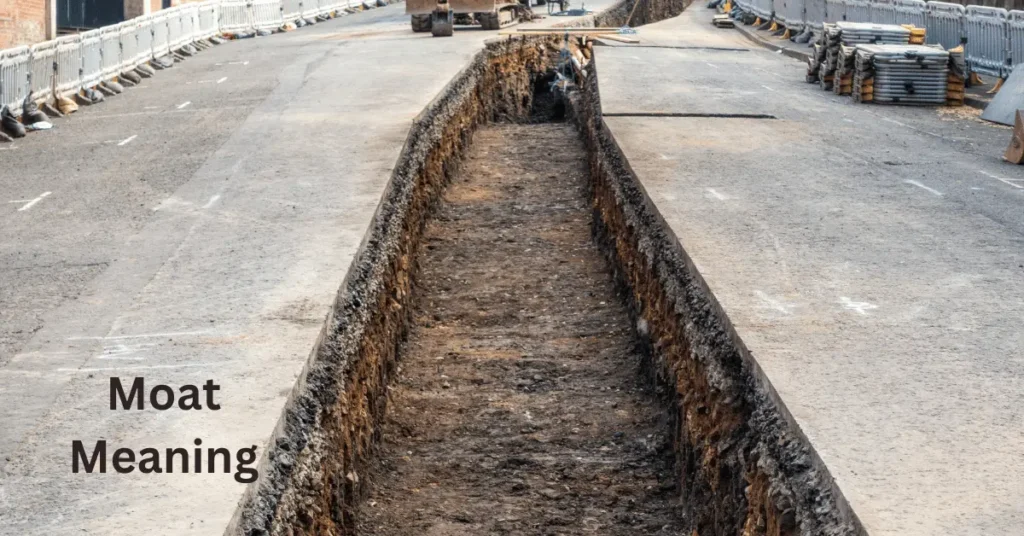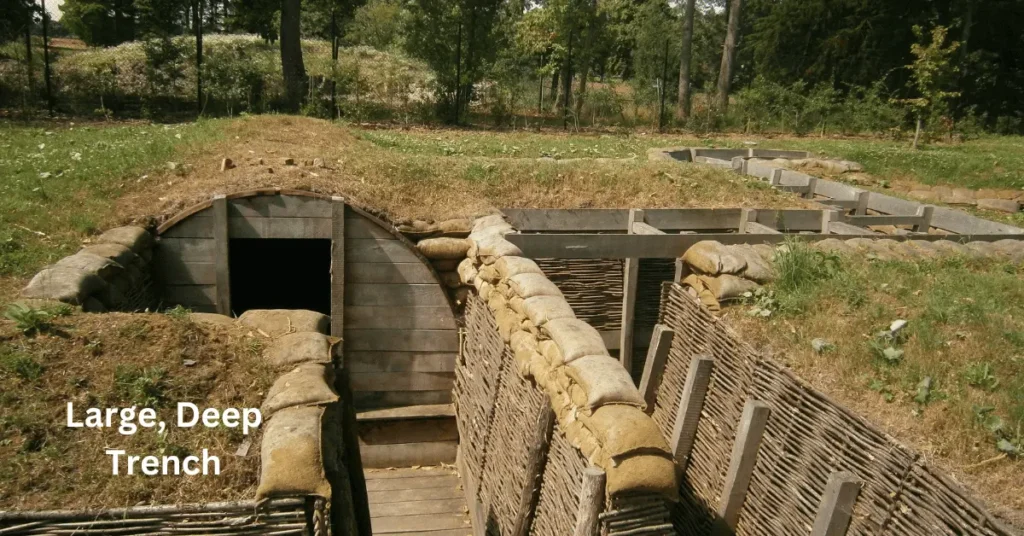Moat Meaning

Have you ever wondered what a “moat” is and why they were so important in history? The term “moat” often brings to mind images of grand castles surrounded by deep, water-filled ditches.
But the meaning of a moat goes beyond just looking impressive. It’s a key feature in the defense systems of ancient fortifications, designed to protect those inside from potential invaders.
In this post, we’ll explore the meaning of a moat, its fascinating history, and how it worked as a protective barrier.
Let’s dive into this intriguing aspect of history and learn all about “moat meaning.”
What Does “Moat” Mean?
A moat is essentially a large, deep trench, often filled with water, that surrounds a fortified structure, like a castle or fortress.
The purpose of a moat is primarily defensive — it serves as a barrier to protect the structure from attacks.
Historically, moats were carefully constructed to make it harder for enemies to approach or breach the walls of a fortification.
The trench could be filled with water sourced from nearby rivers, streams, or man-made channels, making it difficult for attackers to cross.
Some moats, however, were dry, just wide ditches with steep sides to prevent easy access.
These dry moats still created a formidable obstacle, deterring anyone trying to scale the walls or get close to the castle.
Moats weren’t just physical obstacles; they also served as a psychological deterrent.
The sight of a deep, wide trench, possibly filled with water or even dangerous creatures, created a sense of danger and made it clear that the structure within was well-protected.
While the concept of a moat might seem medieval or ancient, the idea of creating physical barriers to protect important places or properties continues today, although modern security measures have replaced the need for moats.
Definition and Examples of “Moat” Meaning
Definition of Moat
A moat is a deep, wide trench that surrounds a fortified structure, like a castle, fortress, or even a town, often filled with water, though some were dry.
The primary purpose of a moat is to act as a defensive feature, preventing enemies from easily reaching or breaching the walls of the fortification.
By creating a significant obstacle between the attackers and the structure, the moat slowed down or stopped invasion attempts, making it difficult for invaders to cross or get close.
The moat could either be filled with water, making it harder for attackers to swim or build bridges, or it could be dry, relying on its sheer depth and width to block access.
Water-filled moats were often lined with sharp stakes or contained dangerous creatures like crocodiles, adding another layer of danger to any potential enemy.
Examples of Moats
The Tower of London, England: The Tower of London is a classic example of a fortress with a moat. Built in the 11th century, this iconic structure was surrounded by a large, water-filled moat.
The moat served to protect the Tower from invaders, making it much harder for anyone to approach the walls.
Over time, the water was drained, but the remnants of the moat remain part of the Tower’s history.
The Château de Chillon, Switzerland: Situated on the shores of Lake Geneva, the Château de Chillon is a medieval castle that still has a functioning moat around it.
The moat is filled with water, making it one of the most well-preserved examples of this defensive structure.
The castle is now a popular tourist destination, allowing visitors to walk around its moat and imagine life in the medieval era.
The Castle of Good Hope, South Africa: Built in the 17th century by the Dutch East India Company, the Castle of Good Hope in Cape Town was once surrounded by a moat, though it has since been filled in.
This historical site is an excellent example of how moats were used in the colonial era to secure important military structures.
These examples showcase how moats were vital to the defense systems of castles and fortresses throughout history, helping to keep intruders at bay and providing an additional line of defense.
While modern technology has rendered moats largely obsolete, they continue to stand as fascinating remnants of medieval military architecture.
Word Origin of “Moat”

The word “moat” comes from the Old French word “mote”, which itself was derived from the Latin word “multa” (meaning “earthwork” or “mound”).
This Latin root relates to the idea of creating a raised structure or barrier, which is very much in line with how moats were used in medieval times — as a protective trench or barrier around fortifications.
The term “mote” in Old French referred specifically to a mound or embankment, which was often part of the earthworks surrounding a castle.
Over time, the meaning of “mote” evolved to describe the trench or water-filled ditch that was created as a defense mechanism.
In Middle English, the word “mote” transformed into “moat”, which now specifically referred to the trench that surrounded a fortification, whether it was filled with water or not.
The “moat” became a common feature in the design of medieval castles, where it served as an essential defensive feature.
Interestingly, the word “moat” has kept its essential meaning throughout the centuries, consistently referring to the deep trench that serves as a protective barrier.
While modern usage of the term has expanded beyond its historical military context, the core idea remains rooted in the original purpose — defense and separation.
This historical evolution shows how the term “moat” has adapted from a broad concept related to earthworks and fortifications into the specific, iconic water-filled trench we think of today.
FAQs
What was the purpose of a moat?
The primary purpose of a moat was to serve as a defensive barrier around fortifications, such as castles and forts. Moats made it more difficult for enemies to approach or breach the walls. If the moat was filled with water, it would prevent attackers from crossing it easily. Some moats were dry, relying on their depth and width to act as an obstacle.
How deep and wide could a moat be?
The size of a moat varied depending on the fortification and its location. Some moats were quite wide — up to 50 feet or more — and deep, sometimes reaching 20 feet or deeper. The width and depth were designed to make it difficult for enemies to cross, either by scaling the walls or using ladders or other tools. Water-filled moats were typically deeper to prevent boats or rafts from being used to cross.
Are there still moats in use today?
While moats are no longer a primary method of defense, some historical castles and fortifications still have well-preserved moats. They are often maintained as part of the cultural heritage and tourist attractions. In modern times, moats are sometimes recreated in landscaping, parks, and gardens for aesthetic purposes, but they don’t serve the defensive function they once did.
Why were moats filled with water?
Water-filled moats provided an additional layer of protection. The presence of water made it difficult for invaders to swim across, and it also helped prevent the use of boats or rafts to sneak in. In some cases, moats were also lined with sharpened stakes or contained dangerous creatures like crocodiles, making them an even greater obstacle for attackers.
How were moats constructed?
Moats were typically dug around the perimeter of a fortification, either by hand or using tools like simple machines. If water was needed to fill the moat, it would be sourced from nearby rivers or streams, or water might be directed from a man-made reservoir. The trench was often reinforced with steep banks to make climbing out difficult. In some cases, a wall or embankment was built around the moat to prevent the ground from eroding.
Conclusion
In conclusion, a moat is a fascinating and important feature of medieval fortifications, designed to protect castles and other structures from attackers.
Whether filled with water or kept dry, moats served as a powerful defense by creating a physical barrier that was difficult for enemies to cross.
While we don’t see moats used for defense today, they remain an iconic symbol of history and are still visible in some well-preserved castles around the world.
Understanding the meaning of a moat helps us appreciate the ingenuity behind ancient defense strategies and how they shaped the architecture we admire today.
Extra Points
- Moats in Pop Culture: Moats are often featured in movies, books, and video games, especially those set in medieval times. They’ve become an iconic part of castle imagery, representing strength and security. Think of fairytales where princes and princesses live in castles surrounded by moats!
- Modern Adaptations: While we no longer use moats for defense, some modern buildings or gated communities still use moat-like features for landscaping. These might not be used for protection, but they can create a beautiful, tranquil environment. Some luxury homes even have water-filled moats as a decorative element.
- Symbolic Meaning: In some cultures, moats are seen as symbols of separation and protection, representing a barrier between the everyday world and something more important or sacred. In this sense, moats can still hold symbolic value, reminding us of history’s methods of keeping safe.
- Engineering Marvels: Building a moat was a huge engineering feat. Not only did it require careful planning to ensure the water source was adequate, but it also had to be wide and deep enough to be effective. Ancient civilizations invested a lot of time and resources to construct these protective barriers.
- Famous Moats Around the World: Some of the world’s most famous castles still have visible moats, such as the Château de Chillon in Switzerland and the Tower of London in England. These moats have become an important part of these sites’ allure, attracting tourists who want to see these historical structures up close.